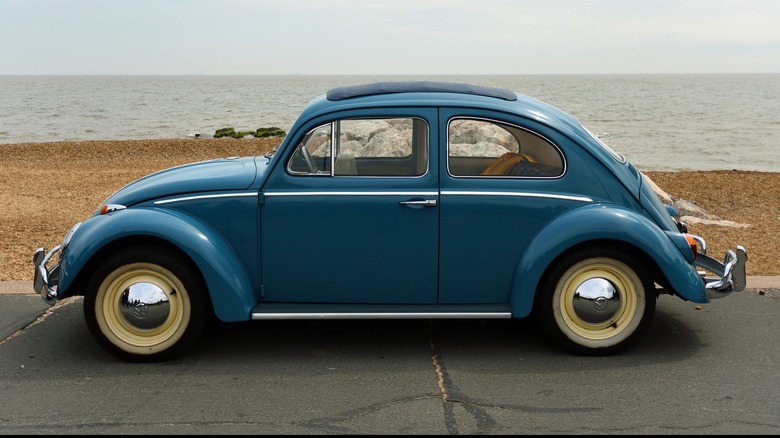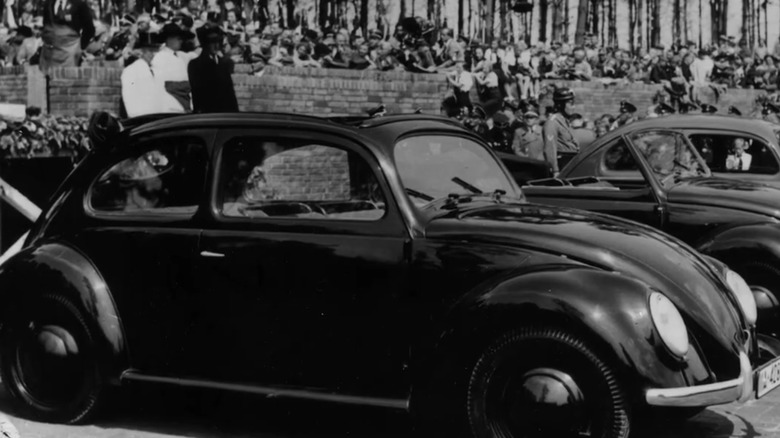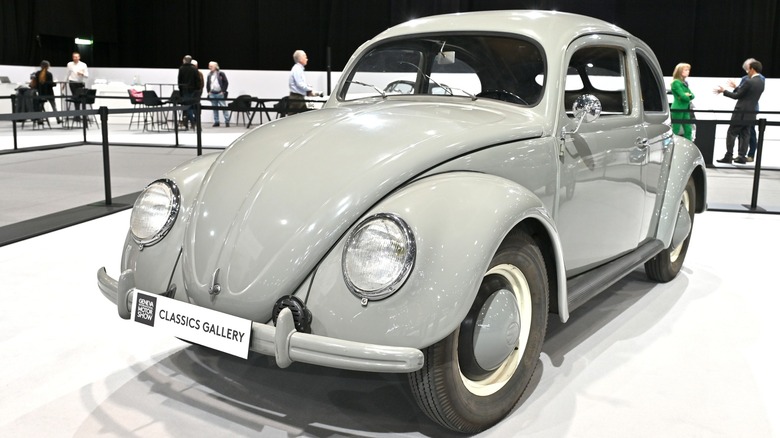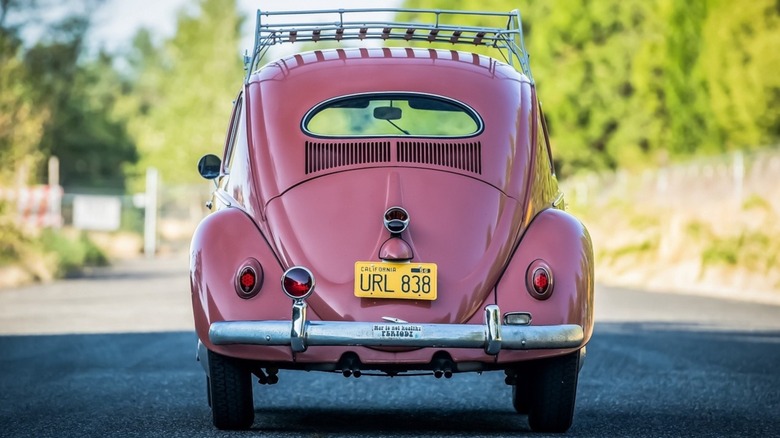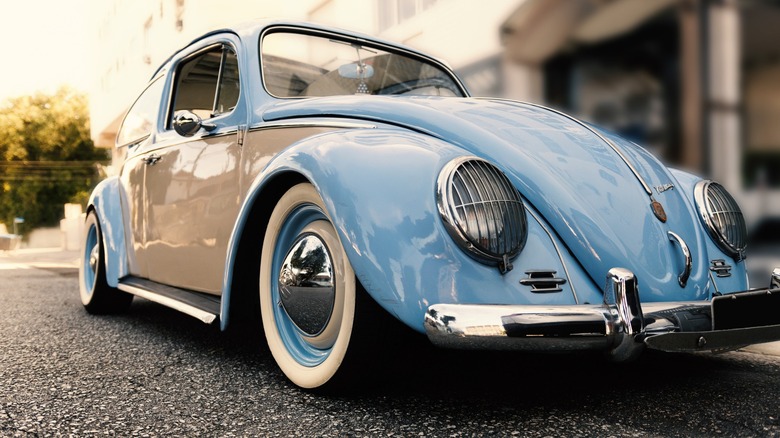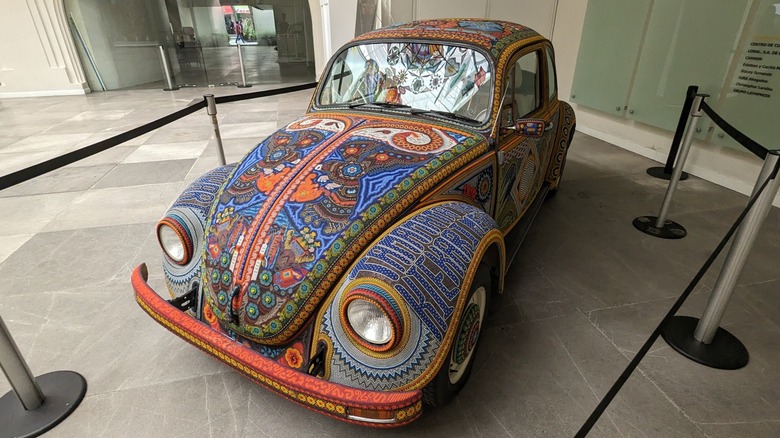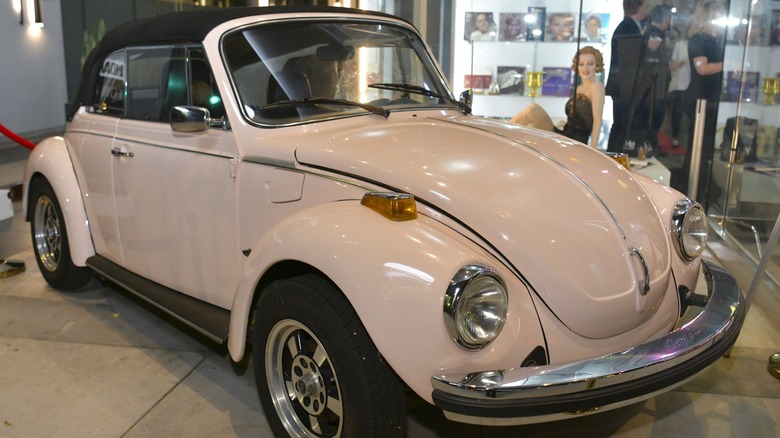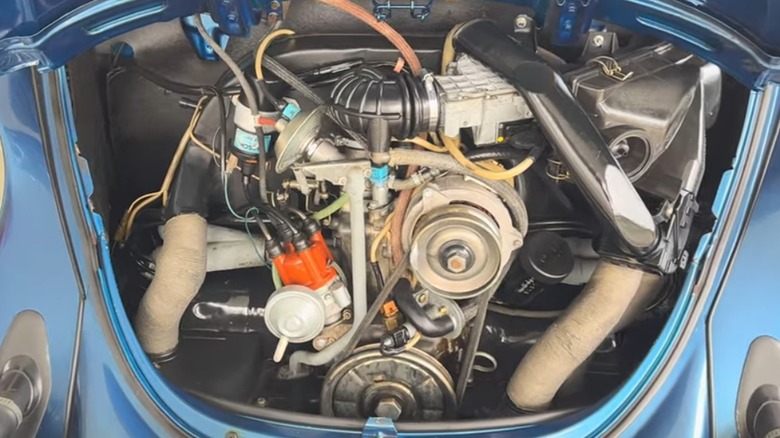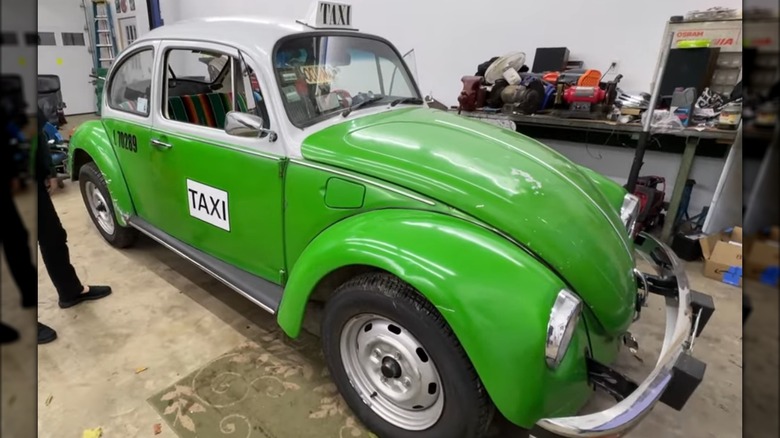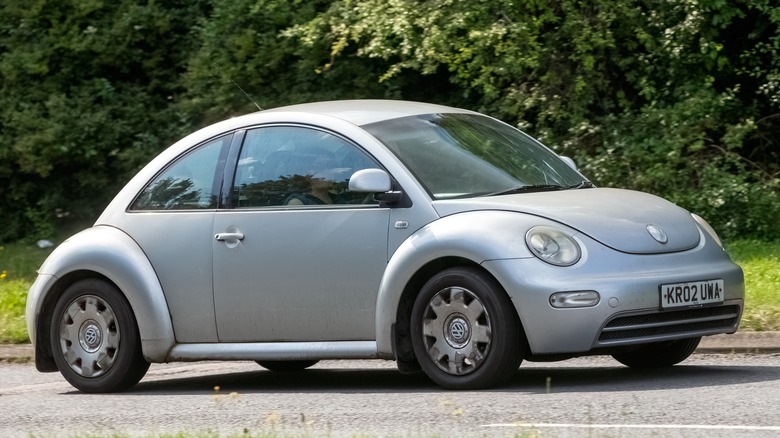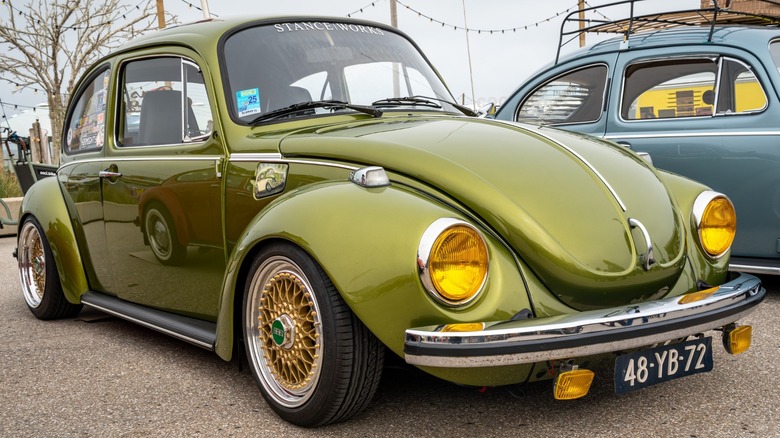Volkswagen Beetle: The Rise And Fall Of An Automotive Icon
Few cars on the road in the post-war period display the kind of recognizable charm and enduring connection to pop culture as the Volkswagen Type 1, commonly referred to as the Volkswagen Beetle. Just to reinforce this point, multiple generations of the Ford F-150 have been the best-selling vehicle in the United States for decades, but its sales overseas remain near non-existent — European sales only began in 2023. The Volkswagen Beetle is represented on all seven continents, including Antarctica. Simply put, people everywhere know the Beetle.
Reinforcing the Beetle's familiarity on a global scale is its incredibly long life cycle. It remained in production for 57 years with few major changes and no overall redesigns. It has also delved deep into popular culture from its roles in countless movies from the "The Love Bug" films to its more recent starring role in the Transformers franchise. It further ingratiated itself to the counterculture of the '60s and later became a favorite of custom car builders, who use Beetles to build dune buggies and more.
It makes no difference from which angle you look at a Beetle, it is iconic. While its technology and design are both archaic compared to modern automobiles, its charm is both compelling and enduring. Although Beetles no longer roll off assembly lines anywhere, we can appreciate them and the story of the rise and fall of this unique automotive icon.
Problematic origins with nefarious roots
In 1933 Germany, massively consequential plans for the world were being concocted by men who would turn out to be among the most despised and despicable of the modern era. Most of these plans sought either domination or destruction of communities far afield from Germany, but one plan of this era created for the German people managed to survive the absolute defeat of the German government in 1945.
After announcing his "people's motorization" in 1933, Germany commissioned a car that would offer the people of Germany affordable transportation for the masses. The task of designing a car fell to Ferdinand Porsche, a skilled industrial designer with much experience in auto design who had already designed a car that nearly fulfilled the requirements, the Porsche Type 12, and used it to develop the new car.
It needed to be an air-cooled car that could carry a family of five with their luggage and cruise at 100 km/h (60 mph) on the newly laid Autobahns available to the average German worker for under 1,000 Reichsmarks, about 31 weeks of the average salary. By 1938, Porsche had delivered a prototype that fulfilled the requirements and a few hundred were built. The initial batch of cars went to military officers, but production abruptly stopped once the invasion of Poland commenced and wartime manufacturing took over. The people's car went dormant but its chassis was put to use to build the Kubelwagen and Schwimmwagen military adaptations.
Rebuilt from the rubble
In 1944, American soldiers liberated forced laborers at the Kubelwagen plant in Stadt des KdF-Wagens, taking it over to use as a repair shop and completing vehicles to use for themselves. Once the war ended in 1945, the British Occupation Zone included the renamed city of Wolfsburg, leaving them responsible for the heavily damaged plant. Initially slated for decommissioning, the plant's salvation came from one enterprising and persuasive British Army Major named Ivan Hirst.
Despite being told the plane had no value by Henry Ford II and British carmaker Sir William Rootes saying nobody would buy the ugly and noisy cars, Major Hirst saw the potential of the factory and the value of restarting civilian automobile production. He found an intact car and sent it to headquarters for evaluation, receiving an order in August 1945 for 20,000 vehicles for use by the British occupying administration. Two weeks later, the order was doubled.
Production ramped up quickly. Military production began in the summer of 1945, and civilian model production began by the end of the year. In 1946, the target of 1,000 vehicles per month was reached and export models began leaving Germany in 1947. 19,000 cars were built in 1948 and double that number the next year. British control of the factory ended in October 1949, leaving the fully revived Volkswagen GmbH with much potential in the hands of the West German federal government.
A second attempt at world domination
Considered part of Germany's "Wirtschaftswunder," or economic miracle, Volkswagen showed how the country could climb out from under the rubble as a manufacturing powerhouse. A third of its production went to export markets in 1950, and the company had plans to expand this to everywhere possible. Max Hoffman, the man who introduced Jaguar, Mercedes-Benz, Alfa Romeo, BMW, and Porsche to America, became the first authorized American dealer in 1950 but failed to gain much traction with the brand and dropped it in 1953.
Despite celebrating 1 million cars produced in Germany in 1955, American sales started slowly, leading to the establishment of Volkswagen of America, Inc. (VWoA) as a subsidiary to handle all American import and sales operations. Volkswagen sold 42,884 Beetles and 6,666 Transporters in 1956 as it worked to expand its dealer network and raise standards for customer service and after-sales.
Americans were slow to take to the diminutive Beetle and even the German head of Volkswagen of America failed to grasp the American auto market. A younger executive with a stronger grasp on the English language replaced him in 1958 to work out the growing pains and establish Volkswagen as a competent option to American buyers. One thing missing from the mix was a good marketing strategy, and when that came, it would change everything.
How thinking small became living large
Launched in 1960, Volkswagen's Think Small marketing campaign became wildly successful and continues to be influential as a model for advertising campaigns today. Advertising agency Doyle Dane Bernbach (DDB) was chosen to help the nascent importer boost its sales and created a campaign to use the Beetle's perceived weaknesses and turn them into strengths. It was risky and bold, but it worked.
At the time, American car companies pushed their cars by focusing on power and luxury, enticing buyers to increasingly bigger cars full of options and accessories. DDB knew Volkswagen would not compete on the same level, choosing instead to highlight how small and simple the cars were, turning them into positive traits for buyers. The campaign used iconic imagery such as showing a small Beetle on a blank page With "Think small." below while another proclaimed the Volkswagen to be "America's slowest fastback."
The results were immediate as Volkswagen sold 120,000 cars in 1960 and saw exponential growth throughout the rest of the decade. It proved that edgy advertising with clever copy could raise brand awareness and entice customers to show up to dealerships, and they did. Furthermore, it is still used today as a case study in good marketing strategy.
Not just an economy car, but a cultural icon
While the Think Small campaign raised awareness of Volkswagen to potential buyers, other factors about the car attracted a different kind of attention, although standing outside of the norm was a common thread. At some point during the '60s, the practical efficiency, rugged durability, and low purchase price attracted a new and young counterculture, including hippies and outcasts, destined to live a life considered unorthodox to the generation that came before.
Its appeal continued to grow with sales, and regular appearances on screens large and small helped to cement its place within the zeitgeist. "The Love Bug" featuring a sentient Beetle named Herbie debuted in 1969, spawning a Beetle movie franchise of a half dozen films while one graced the cover of the Beatles' "Abbey Road" album cover the same year. Jack Nicholson drives one as Jack Torrance drives his family in "The Shining," Kevin Bacon drives one in the 1984 movie "Footloose," and Cuba Gooding, Jr. cruises South Central in a shiny blue convertible in 1991's "Boyz N the Hood."
Beetles have also been a favorite canvas for the art car movement. Some combination of the abundance of cheap used Beetles and the unchanging and endurable design made them popular for use by artists to make them into rolling art and the occasional fixed installment. Even today, Beetles continue to pop up in literature, art, and song, and that will hopefully never change.
Teaching an old Beetle new tricks
By 1968, sales of the Beetle had surpassed 1 million units annually and other models helped fill out the Volkswagen lineup, but they were becoming dated, particularly the Type 1, which was only first called Beetle the next year. While a plan to redesign and update the car had been near completion by 1965, it was shelved as sales of the existing model soared. Nonetheless, it needed a refresh.
Volkswagen released for the 1971 model year a new model called the Super Beetle to be sold alongside the existing model. It retained the same basic shape of the original along with the chassis, but significant upgrades came to the rest of the car. Mechanically, the engine was upgraded with new dual port cylinder heads on either 1,300 or 1,600cc options, and an oil cooler was added to help keep the number three cylinder cool. The front suspension received MacPherson struts while the rear received updated trailing arms to provide an upgraded ride in response to increasing competition from Toyota and Datsun.
A new curved glass windshield provided the most noticeable difference in appearance but new free-flowing cooling vents hopefully made a more noticeable difference while seated inside. Furthermore, moving the spare tire increased cargo capacity by 86%. All in all, the improvements made for a better car, but it was still pure Beetle underneath. Also, the Beetle surpassed the Model T as the best-selling car of all time in 1972 with 15,007,034 produced.
A victim of its own success
Even with the introduction of a revised Beetle, sales saw a sharp decline starting in 1973. Emissions regulations threatened its existence, and after adding fuel injection in 1975, Volkswagen could not keep up. It had released its new water-cooled Golf and focused on making more modern cars, and the archaic Beetle no longer held the same charm.
Air cooling makes it difficult to control emissions as temperature is crucial to obtaining a clean burning car. Volkswagen had already been working on this problem by adding fuel injection to its air-cooled Type 3 in 1968. However, Beetle sales were on the decline throughout the 1970s — German production in Wolfsburg ended in 1974 and in 1978 in Emden, shifting production to Mexico and elsewhere. Volkswagen held on for another couple of years and in 1976, the last American sales concluded. The EPA had finally banned the Beetle in America.
It was the end of an era, although buyers at the time likely did not make much to do about it. With the Rabbit on dealer lots and plenty of Japanese competition, there simply was no longer room for a car from the '30s in the market. And while this would close a chapter on the plucky little Type 1, it was not the end of the story.
Zombie Beetles
Much like the undead that roam the Earth, the Volkswagen Beetle forged ahead without the American and European market. The manufacturing that had shifted to Mexico before it left the American market continued to supply the Mexican market after 1976. Without a Clean Air Act to dictate its emissions output, Volkswagen could continue building its 40-year-old engine technology with abandon. And so they did.
The classic Beetle continued to be sold in Mexico for many years. While they were available to the general public, there was one particular application making them more memorable. Travelers to the country in the latter part of the 20th century and even into the 21st will have seen many Beetles serving as taxis. These cars, known locally as "Vochos," had previously been yellow, but a law enacted in the '90s forced owners to modify engines to run on unleaded fuel and paint them in the now familiar green and white color scheme.
The end of the road, for a time
Sales declined steadily in the waning years of the '90s as more modern and capable competition arrived. Furthermore, concerns over the safety of the archaic taxis grew despite upgrades like disc brakes, three-point seatbelts, and fuel injection being added. By 2003, sales slowed to a trickle, prompting Volkswagen to discontinue production, ending 65 years of production. Additional laws enacted in the following years placed further restrictions on taxis, forcing the Beetles out of service altogether.
Even though this seemed to have placed some finality on the story of the Beetle, a new version, literally called the New Beetle, had already emerged. It debuted in 1997 riding on the Golf platform but with sheet metal reminiscent of the old Type 1. Gone were the air-cooled engine and dead simple mechanicals, replaced by turbocharged and direct-injected diesel engines accompanied by creature comforts, accessories, and upgrades like leather interior. It was much more a throwback than a rebirth of the original.
The New Beetle received one major update in 2011. Dropping New and simply called Beetle, the golf-based car threw a little and took on more modern and mature styling along with even more mechanical and technological upgrades. It was a handsome car that offered drivers what had become a typically premium Volkswagen interior, a far cry from the original. Although it managed enough success to go another eight years, it all ended in 2019, possibly closing the Beetle's door for the last time.
Life after death
With more than two decades having passed since the last Beetle left the factory in Mexico, one might think the car's best days were behind it. After all, its rise to prominence rested on its ability to deliver economical transportation at a low cost and with pain-free maintenance. Some of the most celebrated classic and antique cars began as desirable performance or luxury cars, or sometimes both, such as the factory modified AMG Hammer of the '80s. Despite its lowly position in the automotive hierarchy, the Beetle's popularity seems to be as strong as ever.
One of the things that keeps these cars going is the sheer number originally produced. With more than 21 million built over the decades, they are still relatively easy to find, despite being out of production for decades. Furthermore, the simple and basic nature of the car makes it easy to keep going, and continued demand keeps the replacement parts industry thriving, contributing to the reasons a Beetle is still worth owning. In developing nations such as Ethiopia, Beetles are still common sights as regular transportation, while in Mexico, enthusiasts keep them going as a hobby but also drive them daily.
They are less commonly seen on American streets and highways, but that does not mean they aren't out there. A robust community of owners, customizers, and part suppliers exists, allowing people to do everything from performing a meticulous restoration to high-performance racers. With this kind of support, it appears the Volkswagen Type 1 Beetle will live forever.
